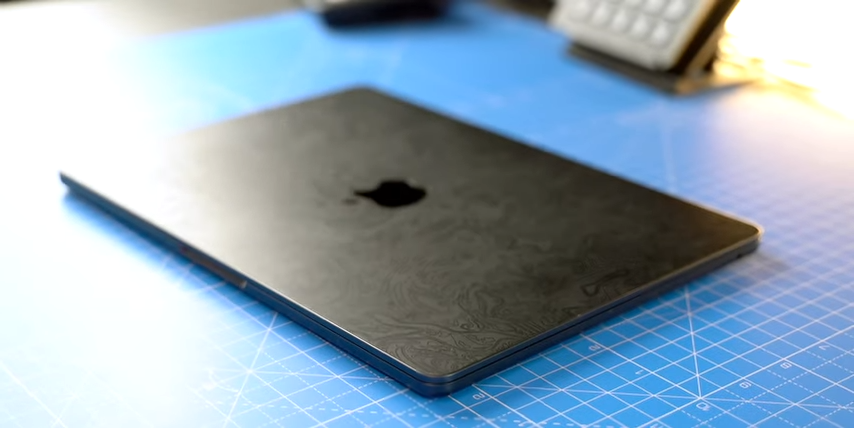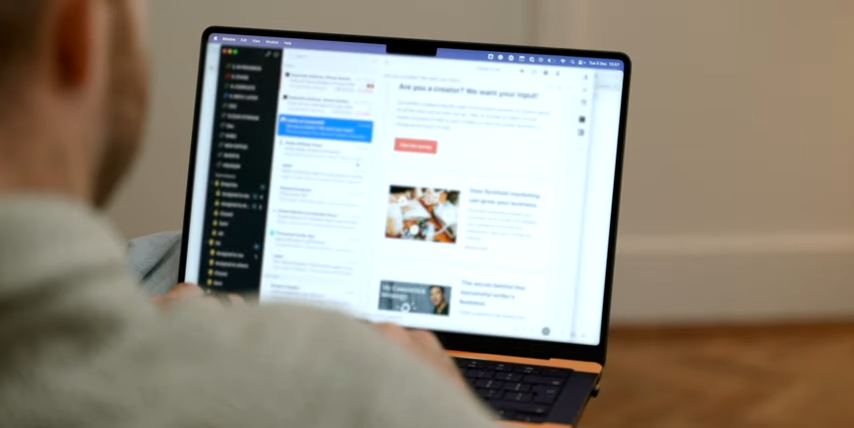I still remember the first time I tried the MacBook Air M1. It was thin, silent, and so much faster than any laptop I’d ever touched.
Fast-forward a few short years, and here we are already talking about the MacBook Air M5.
Apple’s chip cycle moves quickly, and while it’s tempting to think, “maybe I should hold off for the next one,” that line of thinking is exactly how you fall into Apple’s upgrade trap. And before you know it, your budget Air turns into a MacBook Pro Maxed-Out Monster you didn’t plan on.
So before you get caught up in the hype, let’s break down what’s actually realistic to expect from the M5, and whether it’s worth waiting.
Apple’s Chip Roadmap: How We Got Here
The Air has been on quite the ride since Apple ditched Intel. Here’s a quick history lesson:
- M1 (2020): First Mac with Apple silicon, shocking everyone with its speed and efficiency.
- M2 (2022): A modest upgrade… until people discovered the base 256GB model had slower storage speeds because Apple quietly cut it down to one chip instead of two. Sneaky.
- M3 (2023): Fixed the storage bottleneck, added support for dual external monitors (finally), Wi-Fi 6E, and slightly better microphones. Mostly an incremental bump.
- M4 (2024): Debuted in the iPad Pro and was eventually released in the MacBook Air 4. All about efficiency and prepping for Apple Intelligence.
- M5 (expected early 2026): Likely a refinement focused on neural engine performance for AI. Expect another step in efficiency, a little more performance, and marketing slides filled with “Apple Intelligence ready.”
The pattern here is clear: Apple doesn’t redesign the Air every year. Instead, each chip update stretches performance a bit further while locking you tighter into the Apple ecosystem. The question is whether those M5 improvements will matter enough for you to wait.
Design: Will the MacBook Air M5 Look Different?
The MacBook Air had its big glow-up with the M2 redesign: flat edges, MagSafe charging, a slimmer profile, and that infamous notched display. Since then, Apple’s been in “refinement mode” rather than full reinvention.

That means the M5 Air isn’t likely to look radically different. Apple usually sticks with a design for three or four years before overhauling it again, and the M2 design still feels modern. So don’t expect a foldable screen, edge-to-edge glass, or anything wild.
What we might see are a few subtle tweaks, like:
- Slimmer bezels around the display.
- Weight reduction with a lighter frame, possibly using titanium-like materials in the Pros.
- New colour options, maybe another “hero” shade to tempt people into upgrading, while classics like silver, starlight, space gray, and midnight remain.
In short, the M5 Air will almost certainly look like the M2/M3/M4 Air, but polished. Apple knows the Air’s appeal is its balance of thin, light, and premium.
Performance: What the M5 Could Bring
Apple silicon has already proven that you don’t need fans to get serious performance, and the M5 chip will push that even further. But what’s realistic?
Expect the usual bump in CPU and GPU cores, with more efficiency per watt. Everyday stuff, like browsing and video calls, will feel exactly the same as it does on an M3 or M4. Where the M5 will really matter is in:
- Apple Intelligence tasks - The M5’s Neural Engine will likely be the headline. This could mean faster AI summarization, transcription, and an on-device Siri that actually feels useful.
- Video/photo editing - Faster exports, smoother playback in Final Cut and Lightroom. You’ll still want a Pro for serious work, but the Air will creep closer to “pro-enough” territory.
- Gaming - Hardware ray tracing already exists in the M3 and M4, but M5 should make it more efficient. Don’t expect a gaming laptop, but Apple’s slow push into gaming will continue.
- Battery life - Efficiency gains are often more important than raw speed. If the M5 can stretch the Air to two full days of light use, that’s a win.
If you’ve got an M3 or M4, the M5 won’t feel dramatically different day-to-day. But if you’re on an M1 or M2, the leap will be big, especially with the AI features Apple’s going to push hard in 2025.
Display: Pro Features Coming to Air?
Here’s the question everyone asks: Will Apple finally give the MacBook Air ProMotion (120Hz refresh rate)?

The short answer is: almost certainly not. Apple loves keeping that feature exclusive to the Pro models, because it’s one of the few visual differences they can upsell you on.
So what’s more realistic for the MacBook Air M5?
- Brighter HDR support - A small step up from the current Liquid Retina panel, making movies and creative work “pop” a bit more.
- More energy efficient - Even without jumping to OLED or mini-LED, expect a panel that sips less power for the same brightness.
- Slimmer bezels - Apple’s been slowly trimming them down across devices, and the Air could see that refinement too.
Resolution-wise, don’t expect anything new. The Air already has more than enough pixels for its size. What Apple might do is improve colour calibration and consistency so even casual users notice a cleaner look straight out of the box.
In other words, the display will look great, but it won’t steal thunder from the MacBook Pro. Apple wants you to know you’re buying the lighter, thinner option. Not the powerhouse.
Battery Life and Efficiency
If there’s one thing the MacBook Air has always bragged about, it’s battery life. The M1 set the tone with “all-day use,” and every generation since has squeezed a little more runtime out of the same thin build.

With the M5, expect Apple to double down on efficiency rather than headline-grabbing speed. Here’s what that could look like:
- Longer runtime - pushing past the usual 15–18 hours of light use, maybe even flirting with two full workdays if your workload is light (think browsing, docs, email, etc.).
- Cooler under load - more efficiency also means less heat when doing heavier tasks like video exports or light gaming. No fans, no drama.
- AI efficiency - Apple Intelligence features will be baked into macOS by then, and the M5’s Neural Engine will run them with less drain on the battery.
Realistically, this is the upgrade you’ll feel the most in your day-to-day life. You might not notice a faster chip when opening Safari, but you’ll definitely notice if your laptop still has 40% left after a long day.
Ports and Connectivity
Don’t expect Apple to suddenly turn the MacBook Air into a port monster. That’s what the Pro lineup is for. The Air will almost certainly keep the same simple layout:
- 2x Thunderbolt/USB-C ports - one on each side would be nice, but Apple probably won’t go there.
- MagSafe charging - still one of the best comebacks Apple has made.
- 3.5mm headphone jack - for now, at least.
Where we will likely see improvements is in wireless connectivity:
- Wi-Fi 7 support - faster, more stable wireless for anyone with a modern router.
- Bluetooth 5.x upgrades - better audio stability for AirPods and lower latency.
It’s the small stuff that makes the Air feel modern without eating into the Pro’s “power user” territory.
Pricing
If there’s one thing Apple knows, it’s how to keep pricing… consistent. The MacBook Air is Apple’s entry-level laptop, and Apple is very careful not to let it creep too close to the Pro line. That means the MacBook Air M5 will almost certainly start at the same ballpark as today’s models:
- 13-inch MacBook Air M5 - likely around $999 / £1,099 for the base model.
- 15-inch MacBook Air M5 - likely around $1,299 / £1,399.
Where things get expensive is in the upgrades. Storage and memory jumps can easily add hundreds to your bill, which is why so many buyers find themselves dangerously close to MacBook Pro pricing without even realising it.
Should You Wait for the MacBook Air M5?
This is the big question: do you buy a new (or used) MacBook Air now, or hold out for the M5? The answer depends on what you’re currently using and how badly you need an upgrade.
Who Should Buy the MacBook Air M5?
The MacBook Air M5 will almost certainly be the best Air yet, but that doesn’t mean you should freeze your wallet until it lands. Buy what you need, when you need it, and don’t get trapped in Apple’s vicious upgrade cycle.
The Air Is Still Apple’s Best Laptop
The MacBook Air has quietly become Apple’s most important laptop. It’s the one students buy, the one travellers swear by, and the one I usually recommend to anyone who just needs a machine that works every single day without drama.
The MacBook Air M5 will push that even further with better efficiency, smarter Apple Intelligence support, and just enough tweaks to make it feel new. However, you don’t need to sit on your hands waiting for it. The MacBook Air M3 and M4 are already excellent, and they’ll stay fast for years.
So if you’re due an upgrade now, don’t stress about what’s next. If you’re happy with what you’ve got and can wait, the M5 will be the one to watch. Either way, the Air remains the best balance of price, portability, and performance in Apple’s lineup.


